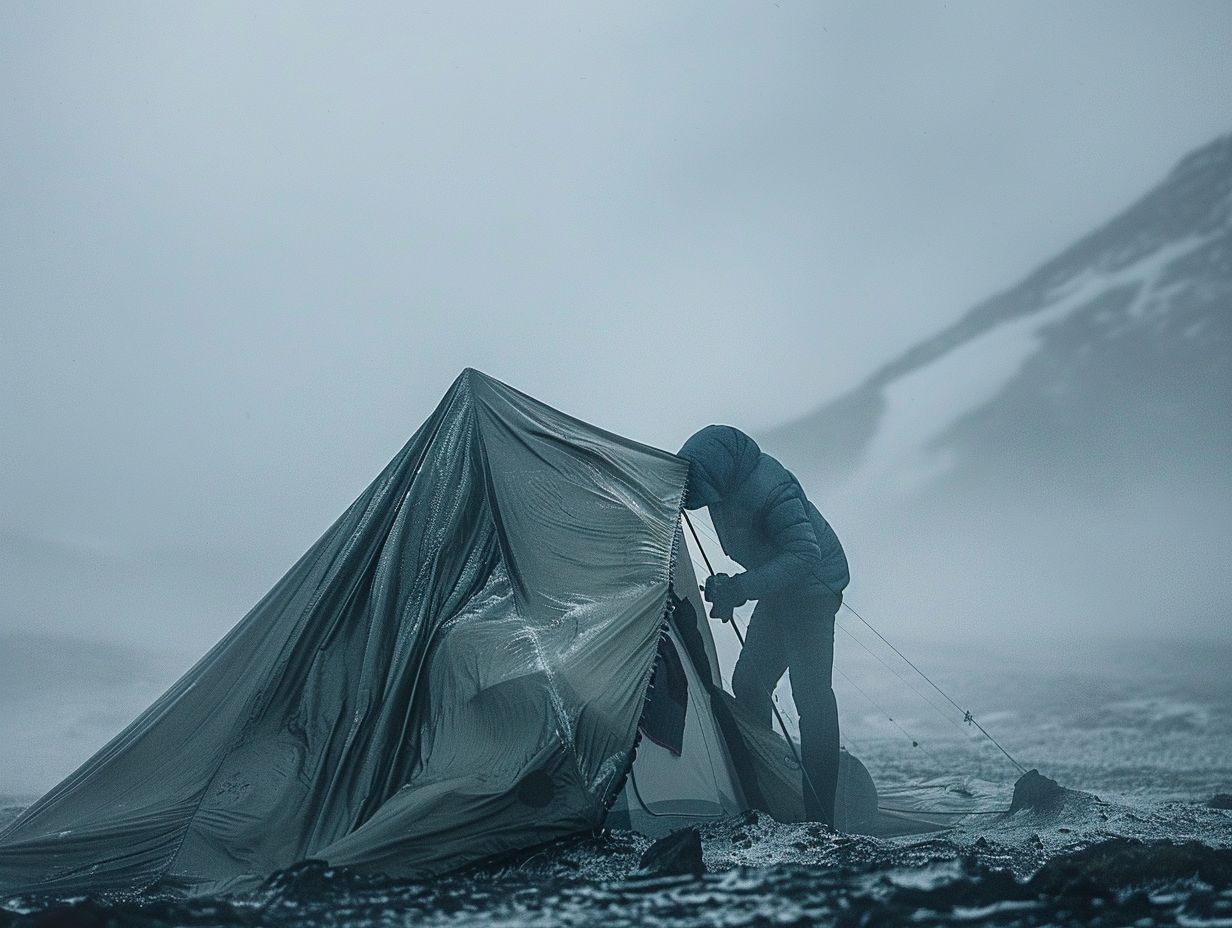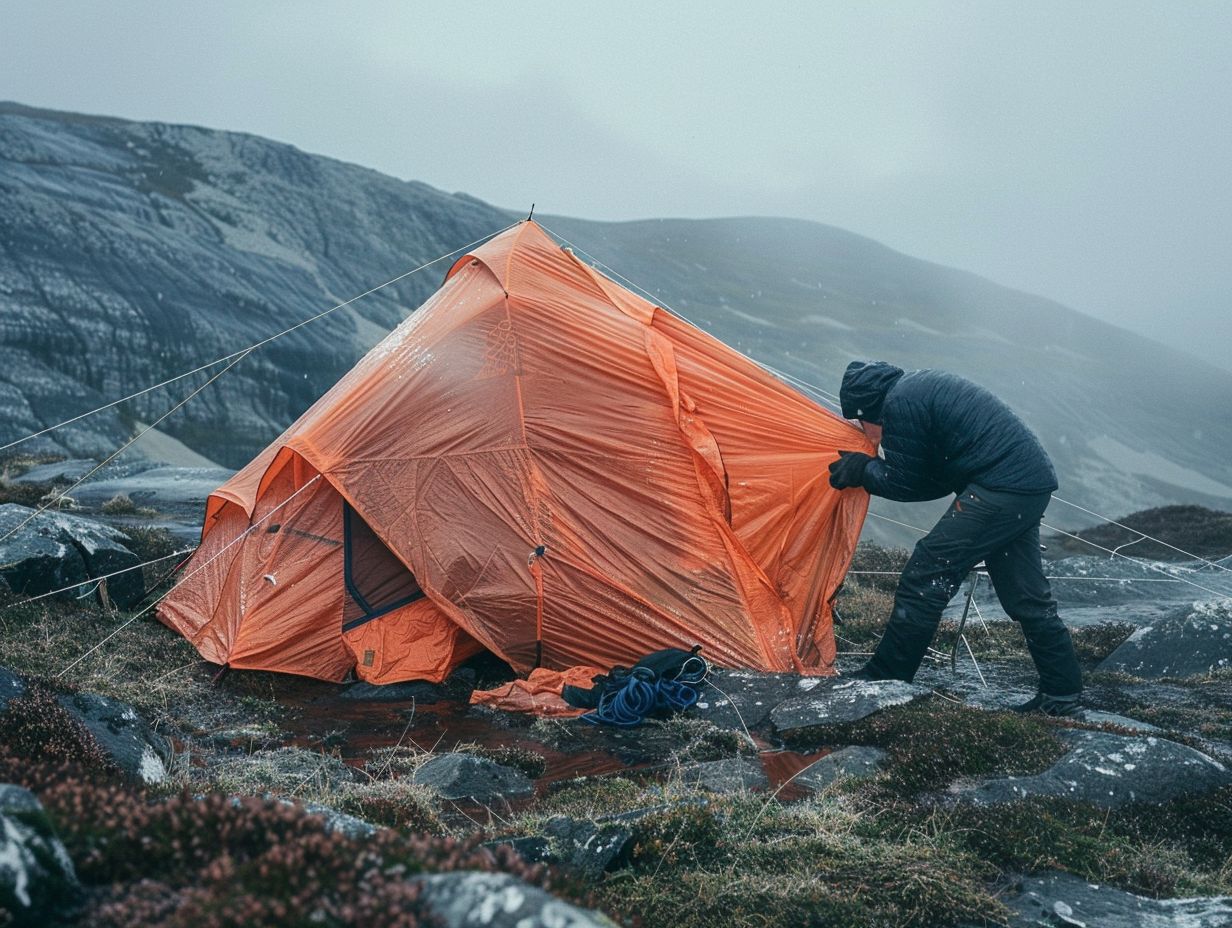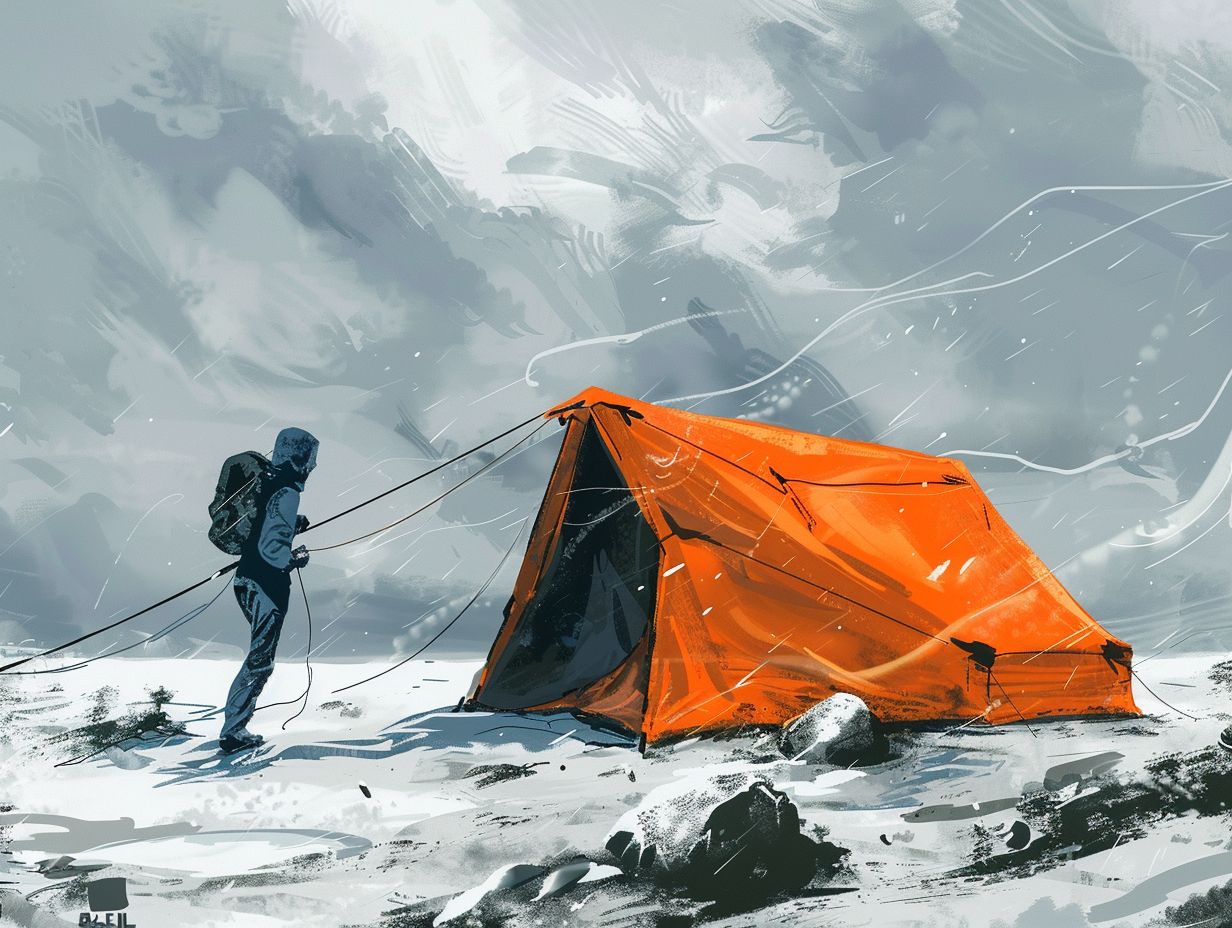As an adventurous camper who enjoys spending time in nature, you understand the significance of selecting a suitable tent for windy conditions.
In this guide, we will delve into the ways in which wind can affect your tent, the essential features to seek in a wind-resistant tent, and the proper methods of securing your tent prior to a storm.
Additionally, we will address the importance of monitoring and adjusting for evolving wind conditions during a storm, as well as evaluating and repairing any resultant damage post-storm.
Be sure to stay tuned for advice on preempting wind-related damage in the future and guaranteeing a safe camping excursion.
Key Takeaways:

- Choose a tent specifically designed for windy conditions, with features such as sturdy poles and a low profile design.
- Properly stake and anchor your tent before a storm, and monitor and adjust for changing wind conditions during the storm.
- After a storm, assess and repair any wind damage, and take preventative measures for future camping trips to avoid wind damage in the first place.
Understanding Wind and its Impact on Tents
Understanding Wind and its Impact on Tents is crucial for safe and enjoyable camping experiences. Mother Nature can unleash powerful winds that challenge the stability and security of your shelter. During camping trips, encountering windy conditions is not uncommon, and being prepared is key to ensure a successful outdoor adventure.
High winds can not only make setting up and maintaining your tent more challenging but also pose a safety risk to campers. Selecting a tent with a sturdy frame, guy lines, and wind-resistant materials like ripstop nylon or polyester can greatly improve its ability to withstand gusts.
Properly anchoring the tent and orienting it to face the wind direction can also help minimise the impact of strong winds, providing a more secure and comfortable camping experience.
How Wind Can Affect Your Tent
Strong winds can have a significant impact on the stability and safety of your tent during camping trips. Understanding how wind affects your tent is essential for proper preparation and protection.
One of the risks of strong winds is that they can cause tents to become unstable, leading to potential collapse or damage. Properly anchoring your tent is crucial to prevent it from being blown away by gusts of wind.
Using sturdy pegs or pegs to secure the corners and guy ropes to provide additional support can help in maintaining the stability of the tent. Positioning your tent strategically, such as facing it away from the direction of the prevailing wind, can reduce the impact of wind on the structure.
Choosing the Right Tent for Windy Conditions
When selecting a tent for windy conditions, it is imperative to choose one that will provide the necessary protection in challenging weather conditions. Opt for a sturdy and wind-resistant tent, as this will be crucial for a successful camping experience.
When searching for a tent that can withstand windy conditions, it is essential to prioritise material durability. Choose tents crafted from high-quality, weather-resistant materials such as ripstop nylon or polyester, known for their strength and ability to endure strong winds. The durability of the material will be a key factor in the tent’s performance during adverse weather conditions.
Along with material durability, the design stability of the tent is paramount in ensuring its performance in windy weather. Look for tents equipped with sturdy poles, guy lines, and proper anchoring systems to enhance stability during windy conditions. A well-designed tent will offer better protection against the elements.
Furthermore, portability is crucial, especially when camping in windy conditions. Opt for lightweight and easy-to-assemble tents, as they will make it easier to set up quickly and securely in challenging weather. Prioritising portability will enhance the overall camping experience and provide added convenience during setup and takedown processes.
Features to Look for in a Wind-Resistant Tent
When selecting a tent for windy conditions, certain features are pivotal in improving wind resistance and stability. Understanding these essential components can assist you in choosing the most suitable shelter for your camping requirements.
One critical factor to evaluate is the anchoring options that accompany the tent. Utilising heavy-duty stakes, preferably crafted from robust materials such as aluminium or steel, can securely anchor the tent to the ground and prevent it from being lifted by strong winds.
Additionally, durable tent poles, typically composed of lightweight yet sturdy materials like fibreglass or aluminium, offer crucial structural support. To further enhance the tent’s stability in gusty conditions, ensure that guy lines are effectively positioned and correctly tensioned.
Supplementary accessories such as windbreaks, storm flaps, and geodesic designs are also valuable enhancements that aid in reducing wind resistance and bolstering overall durability.
Choosing the Right Tent for Windy Conditions

When selecting a tent for windy conditions, it is important to consider factors that will enhance your camping experience. Elements such as the material, design, and stability of the tent are critical in ensuring that it can endure challenging weather conditions.
In the search for a tent suitable for windy conditions, choose models constructed from robust materials like ripstop nylon or polyester, as these offer increased resistance to tearing and abrasion. Features such as low-profile designs, geodesic shapes, and multiple guy-out points are beneficial in distributing wind load evenly and enhancing stability.
Opt for tents equipped with sturdy and flexible poles, preferably crafted from aluminium or carbon fibre, as they are better equipped to withstand gusts. Additionally, a double-wall construction with a rainfly that extends to the ground can offer additional protection against strong winds and prevent rain infiltration.
Features to Look for in a Wind-Resistant Tent
Identifying key features in a wind-resistant tent is crucial for ensuring that your camping shelter can withstand challenging weather conditions. By understanding the necessary components, you can enhance the stability and security of your tent.
Anchors play a vital role in securing a tent against strong winds by providing a stable foundation. Properly anchoring a tent involves driving the stakes into the ground at a 45-degree angle, ensuring they are firmly in place. Guylines, which are attached to the tent structure, help distribute wind force evenly and prevent the tent from collapsing.
Utilising additional accessories like sandbags or heavy rocks can further reinforce the tent’s stability in windy conditions. By employing these setup techniques and accessories effectively, you can significantly improve your tent’s wind resistance.
Securing Your Tent Before the Storm
Securing Your Tent Before the Storm is a critical step in ensuring the safety of your shelter and belongings. Properly anchoring and securing your tent can prevent damage and offer peace of mind during adverse weather conditions.
By taking the time to securely anchor your tent, you can avoid potential hazards such as the tent collapsing or being blown away by strong winds. Utilising effective anchoring techniques, such as using robust tent pegs driven into the ground at a 45-degree angle and ensuring they are fully inserted, is essential for maintaining stability.
Guying out your tent by attaching guy ropes to the tent’s corners and then pegging them out at a 90-degree angle can further enhance stability in windy conditions. Remember to regularly check and adjust the tension of your guy lines to keep your tent secure and prevent flapping in the wind.
Properly Staking and Anchoring Your Tent
Properly staking and anchoring your tent is essential for withstanding windy conditions and ensuring the stability of your shelter. By employing effective anchoring techniques and secure pegs, you can enhance the wind resistance of your tent.
- Begin by selecting a suitable location that is relatively flat and away from areas prone to water accumulation, such as hollows or valleys.
- Once you have chosen the ideal spot, hammer the pegs into the ground at a 45-degree angle away from the tent, ensuring they are securely fixed.
- Using guy ropes attached to the tent’s corners and additional anchoring points can further strengthen the structure against strong winds.
Additional Precautions for Extreme Wind
In extreme wind conditions, it becomes imperative for you to take additional precautions to secure your tent. By anticipating unpredictable weather patterns and implementing advanced anchoring techniques, you can protect your shelter from potential damage.
One effective method for improving tent stability in adverse conditions is to use specialised anchor systems specifically designed to withstand strong winds.
These anchors, such as heavy-duty stakes or screw-in types, offer a reliable foundation for your tent. When you pitch your tent, ensure that the anchors are driven deeply into the ground at an angle away from the direction of the wind to prevent them from being dislodged.
Regularly assess and adjust the tension of guy ropes connected to the tent to maintain optimal stability. Monitoring weather forecasts through dependable tools and applications can help you stay abreast of upcoming weather changes, allowing you to proactively reinforce your tent setup before facing extreme conditions.
During the Storm: How to Protect Your Tent

During a storm, protecting your tent becomes crucial to prevent damage and ensure the safety of those inside. By implementing strategies to reinforce the anchoring and stability of the shelter, you can minimise the impact of strong winds and turbulent weather conditions.
To enhance the security of your tent, consider reinforcing the anchors with longer and stronger stakes that can penetrate deeply into the ground. It is also beneficial to set up additional support structures like windbreaks or natural barriers to shield your tent from harsh wind gusts. When choosing a tent location, opt for areas that are sheltered from direct wind exposure, such as behind natural barriers like trees or boulders.
For added safety, firmly plant the tent legs by pushing them into the ground and using rocks or water weights to weigh them down. Adjusting the guylines attached to the tent can help evenly distribute tension and improve stability in windy conditions.
Monitoring and Adjusting for Changing Wind Conditions
Continuous monitoring and adjusting for changing wind conditions are essential to maintain the stability and security of your tent during a storm. By staying vigilant and making necessary adjustments, you can protect your shelter from potential damage.
Ensuring your tent has stable anchors is crucial in windy conditions. Adjustable guy lines provide flexibility to counter varying wind directions while reinforced tent designs offer extra durability. To further secure your tent, adjust straps to remove any slack and reinforce anchor points with additional stakes or pegs.
In case of extreme conditions, utilising rocks or ballasts around the tent base can provide added stability. These measures help fortify your tent against strong winds and ensure a safe shelter.
After the Storm: Assessing and Repairing Damage
After the storm passes, assessing and repairing any damage to your tent is crucial to ensure its longevity and functionality. Conducting a thorough inspection and timely repairs can extend the lifespan of your shelter and maintain its performance in future camping trips.
Begin by carefully examining the tent fabric for tears, holes, or abrasions. Make sure to check all seams and stress points for any signs of damage. Next, evaluate the condition of the tent poles for bends, cracks, or missing segments, as these could affect the tent’s stability.
Use a repair kit specifically designed for tent fabric to patch up any holes or tears. Reinforcing seams with seam sealer can help prevent leaks. Remember to clean your tent with a mild soap and water solution, then allow it to air dry completely before storing it in a cool, dry place to prevent mould and mildew growth.
Steps for Checking and Fixing Wind Damage
When checking and repairing wind damage to your tent, you need to adopt a systematic approach to assess the damage and carry out effective repairs. By following specific steps for inspection and restoration, you can restore your tent to optimal condition for future outdoor use.
- Start by conducting a thorough examination of the fabric to identify tears, holes, or weakening caused by the wind.
- Check all seams for signs of stress or damage, as these are common areas where leaks may occur.
- Address any issues with the tent poles to ensure they are securely in place and free from damage.
- Use appropriate patches and adhesives to repair any tears or holes, and apply waterproof sealant to fix any leaks.
- After completing the repairs, clean the tent meticulously to remove dirt and debris.
- Apply protective coatings to enhance its durability.
- Make sure to store your tent properly in a dry, cool location to prevent mould and mildew growth, thus extending its lifespan.
Tips for Preventing Wind Damage in the Future
Implement proactive measures to prevent wind damage in the future to enhance the durability and resilience of your tent during camping trips. By incorporating protective strategies and maintenance routines, you can minimise the risk of damage and ensure the longevity of your shelter.
Regular maintenance checks are crucial in identifying potential weak points in your tent’s structure or anchoring system. Ahead of each trip, inspect the poles, stakes, guy lines, and seams to proactively address any issues.
Invest in quality tent stakes and anchors that are suitable for different ground conditions. Utilising heavy-duty stakes or specialised anchors designed for windy conditions can significantly improve the stability of your tent.
When setting up your tent, take note of the prevailing wind direction and orient it to minimise exposure. Opt for a low-profile setup or utilise natural windbreaks to reduce the impact of strong gusts on your shelter.
Preventative Measures for Future Camping Trips

To safeguard your tent against wind damage and ensure a more enjoyable outdoor experience, it is important to take preventative measures for future camping trips. By incorporating protective strategies and maintenance routines, you can proactively address potential risks and enhance the longevity of your shelter.
Regular maintenance is crucial in identifying any wear and tear on your tent fabric or frame. Before each trip, be sure to check for loose seams, zippers, and tears, and promptly make any necessary repairs.
When setting up your tent, ensure secure anchoring by using sturdy stakes and guylines. Opt for a weather-conscious setup by considering elements such as wind direction, potential rainfall, and ground conditions. It is also advisable to choose a durable tent that aligns with the expected weather conditions.
By taking these precautions, you can ensure the stability and safety of your tent, regardless of the weather challenges you may encounter during your outdoor adventures.
Frequently Asked Questions
What are some ways to secure my tent in high winds?
There are several methods you can use to secure your tent in high winds. These include staking, tying down the corners, using additional guy lines, and adding weight to the tent.
How do I properly stake my tent in high winds?
When staking your tent, make sure to use sturdy and long stakes. Drive them into the ground at a 45-degree angle and make sure they are fully secure. You can also use a mallet or rock to help drive the stakes into the ground.
What should I use to tie down the corners of my tent in high winds?
It is recommended to use strong ropes or nylon straps to tie down the corners of your tent. Make sure to tie them tightly and securely to the stakes.
Can I use additional guy lines to secure my tent in high winds?
Yes, you can use additional guy lines to provide more stability to your tent in high winds. These lines can be tied to nearby trees or rocks for extra support.
How can I add weight to my tent to make it more secure in high winds?
You can use heavy objects such as rocks or logs to add weight to the corners or sides of your tent. This will help anchor it down and prevent it from blowing away in strong winds.
What precautions should I take to secure my tent in high winds?
In addition to properly staking, tying down, and adding weight to your tent, it is also important to choose a sheltered campsite and properly orient your tent to the wind direction. You should also regularly check and reinforce your tent’s security during periods of high winds.



